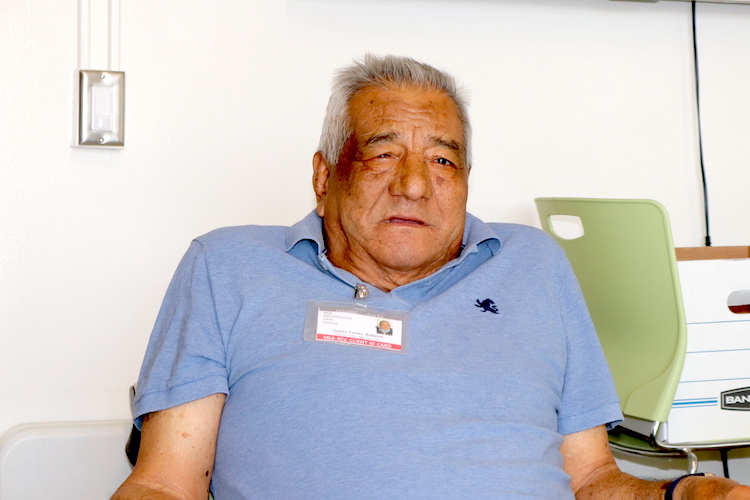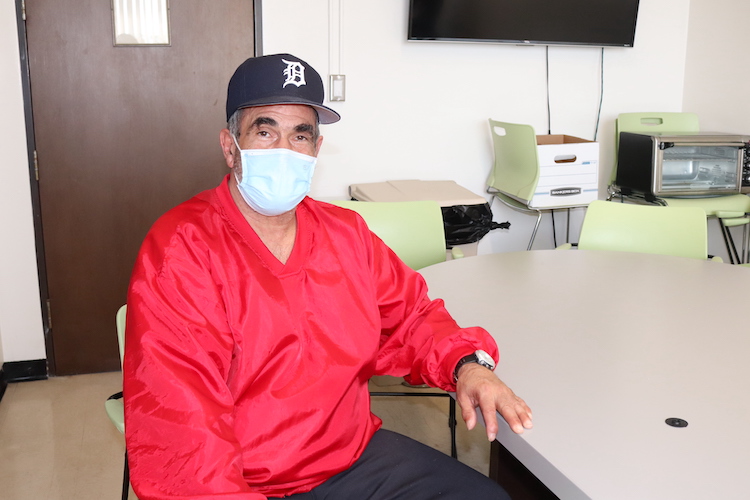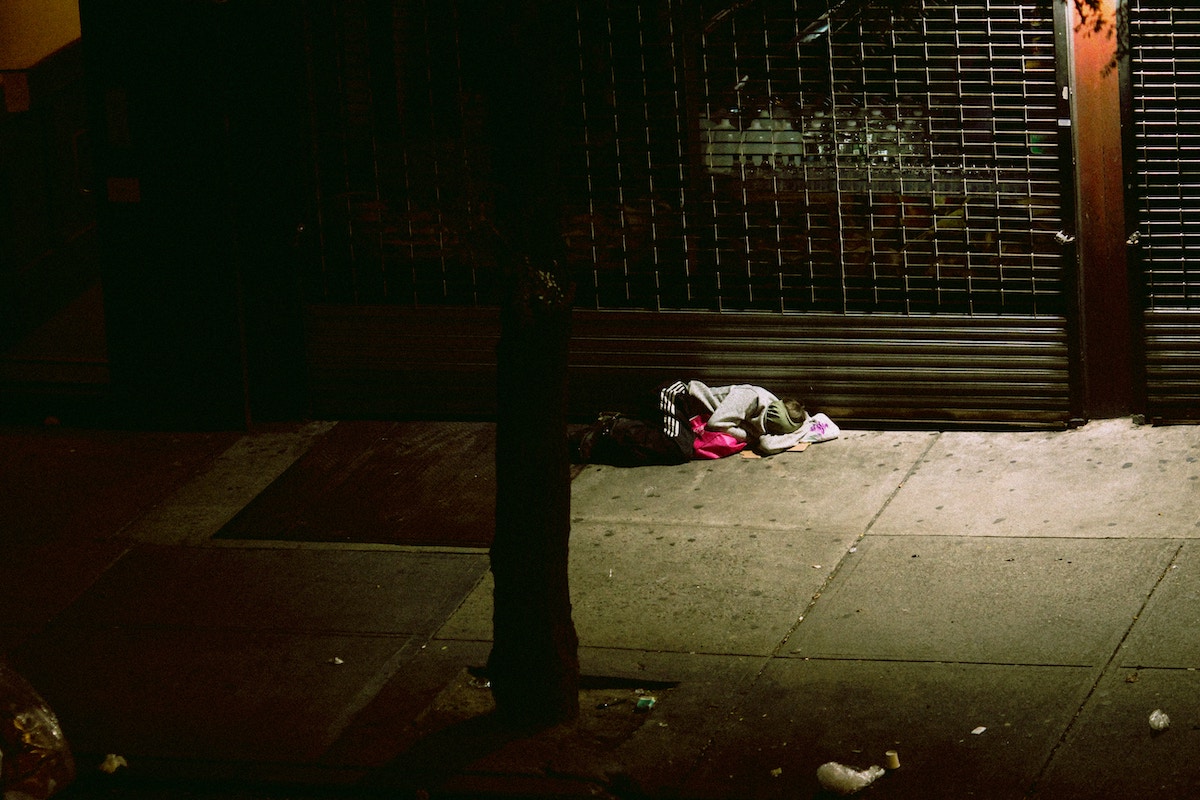Leer en español
Knee and back problems were plaguing 75-year-old Roberto Juarez a couple of years ago, and he found himself unable to work and running out of money to pay for the little room where he lived in Los Angeles. He was about to be homeless.
Today, Juarez has had two surgeries on his spine and knee, with three more to come, and not only has he not ended up on the street, but he has a home and services 24 hours a day.
That’s all thanks to “Housing for Health,” a Los Angeles County program that provides housing and support for sick people who are homeless or at risk of homelessness.
“This help was my salvation,” Juarez says during an interview at the Martin Luther King Jr. Recovery Resource Center, where he has lived since November. Before that, he spent eight months at a Holiday Inn in Long Beach, all covered by the County Department of Health Services program.
“I would have been on the street somewhere, and I was probably going to get sicker,” he says, smiling shyly before adding, “I’m doing great here, and I hope to be here as long as they’ll let me.”
Not just another statistic
With deteriorating health, lack of immigration documents, and no family to rely on, Juarez was destined to be one more in a statistical trend of recent years, in which more and more Latinos, many of them elderly, end up joining the ranks of people without housing and left to fend for themselves on the streets of Los Angeles.

“Our program focuses on people with a medical condition that they need to recover from and cannot return to the streets,” explains Jerri Santo, program director of the MLK Recuperative Care Center. This temporary living facility is part of Housing for Health.
“We have people with recent amputations, gunshot wounds… they can also have, and often do have mental health and substance abuse issues,” Santo explains. She adds that since opening in 2017, after LA voters approved Proposition H to provide more homeless support, she has seen more and more adult and elderly Latinos come for services.
Housing for Health is one of several programs created to combat homelessness paid for by Prop H and by Prop HHH, passed by LA voters in 2016. Still, homelessness in the region continues to rise.
“Just because homelessness is growing doesn’t mean we’re not providing homes to hundreds or thousands of people a month or a year in the state of California. We indeed are,” says Chris Contreras, director of Brilliant Corners, an organization that, along with the county’s Department of Health Services, provides solutions that include housing and services for the most vulnerable populations. “But the number of people who become homeless is greater than those we can help every day.”
More Latinos living on the street
Latinos are among those whose presence within the homeless population has grown most rapidly in recent years, particularly during and after the pandemic.
The number of Latinos identified as homeless in LA County increased by 26% between 2020 and 2022. According to the latest count from the Los Angeles Homeless Services Agency, 44.5% of the homeless population is Latino, an increase of 16%.
COVID’s impact on the Latino population was significant. Still, previous conditions increased this group’s vulnerability to homelessness, as several analyses point out. Melissa Chinchilla, a scientist in the Department of Psychiatry and Behavioral Sciences at the University of California, Los Angeles (UCLA) School of Medicine, has studied the issue extensively.
“Latino homelessness is complicated by immigration status, cultural and linguistic barriers, and low-income status. Moreover, these factors often overlap, creating a complex picture of homelessness,” Chinchilla notes in a report published by UCLA’s Latino Politics and Policy Initiative.
Roberto Juarez is a case in point. The man has been in this country for 30 years but has no papers. His only brother who sponsored his residency died from cancer in 2014. Juarez doesn’t speak English or know where to ask for help.
But during a doctor’s visit a social worker learned of Juarez’ situation and connected him with county services.
“No one can recover from a health problem by living in a vehicle or a tent on the street,” explains Laura Hamilton, spokeswoman for the county’s Department of Health. “This is the type of person Housing for Health focuses on – you must be indoors if you want to recover. People like this are dying on the streets.”

Opioids, overdoses fuel rising homelessness
Addiction is another factor behind the increase in homelessness among Latinos. Overdose deaths within this population doubled between 2016 and 2019, and likely continued to rise during the COVID-19 pandemic, in part due to the flood of synthetic drugs like fentanyl and methamphetamine which continues to devastate communities across California and the country.
62-year-old Cuban-born Enzo Rogelio Crucet spent several years living out of his vehicle, first alone and later with his wife in Massachusetts, where she had children from a previous marriage. He returned to Los Angeles after she died of cancer.
According to Crucet, his 82-year-old mother lives here in LA but he cannot stay with her because she lives in a subsidized apartment that does not admit other residents. Enzo is also ineligible for most public programs because, like Roberto, he is undocumented.
One day, Enzo collapsed in his car and went to the hospital, where he was diagnosed with colon cancer. A social worker connected him with county programs, and he now lives in the same facility as Roberto.
“Yes, I used drugs; I’ve used them since I was 13… but since I’ve been here, I don’t. I’m clean,” he says.
Enzo is receiving treatment for his cancer, and now all he can think about is recovering and getting back to work in a kitchen as he did before his illness.
“They take care of me here and even do my laundry,” he notes. “When I arrived, I didn’t know if fighting cancer would be worth it. But here, everyone has a kind word, and they help you. That has made me feel like I have the will to fight.”
Feature image via Unsplash













